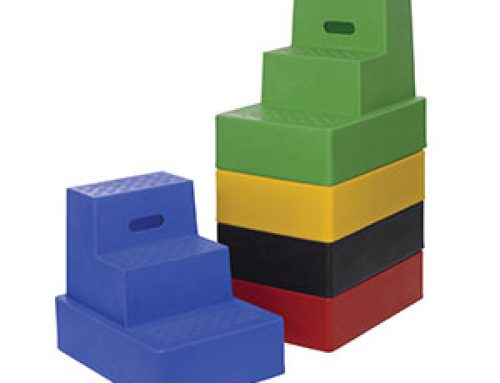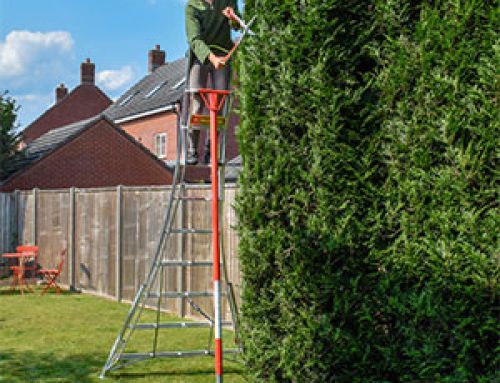There are many different types of step ladder and small hop-up solutions available, so when you're looking at investing in an access solution such as a step ladder it's important to make sure you have considered all the available options.
What sets a step ladder apart from other types of ladder?
Step ladders differ from other types of ladder in their construction and use. Step ladders are hinged at the top, creating an "A" shape when they are deployed. They fold at the hinge for easy storage, and most taller step ladders have a hand-hold and a platform at the top. Instead of rungs, the step ladder has treads, which are generally wider and reflect the different nature of the use of such a ladder; step ladders are often used when carrying or holding objects taking them to or from a high shelf, or for decorating where you want a larger, more stable area for your feet. They are free-standing, so if you are needing to access the middle of a ceiling (for changing a light bulb, for example) a step ladder is the way to go.
Types of step ladder
There are smaller products within the family of step ladders. These include hop-up type steps, which also take the form of an a-frame but have no handle. These are usually two or three treads tall and are used mainly by handymen and decorators to reach up to curtain rails or high cupboards. They are lightweight and compact and can be easily moved around with one hand, leaving the other free to hold tools. They also often have treads on both sides of the frame (unlike a traditional step ladder, which only has treads on one side). This makes hop-up steps incredibly versatile in situations where you need to move around quickly. They are better used by people with good balance, as there is no top handle or anything to lean on.
The kik-step is something you will have seen in shops and libraries. It looks like a cross between a stool and a Dalek! They move on pressure sensitive castors that lock when the step is being stood on. The top is the main platform area, and there is usually an integral tread within the unit However, as they are generally less than half a metre tall, they are easy to step on and off. The name "kik-step" gives you a pretty good idea of how it is used. They are so light you can kick, or nudge the unit around the area you're working in and then simply step back on it. These types of small steps are useful in kitchens and in study/library rooms as they also function well as an extra seat and are small enough to be pushed under a table when not in use. They have a rubberised surface on the integral tread and on the top as they are designed for use in every day situations where good grip is needed.
Kitchen steps and step-stools are generally a domestic solution. These types of step ladders are shorter than an industrial or decorating step ladder, as they'e designed for use around the home, where you might be needing to access the top of a cupboard for cleaning, tidying etc. They also have much wider rubberised treads than other types of step ladder, as they are designed to be used by people who probably aren't wearing safety shoes with good grip. A step stool is a variant of the typical kitchen steps, which has a larger top tread. Although not quite a platform in the strictest step ladder sense, this top tread is larger in order to function as a seat. Step stools can be quite useful as a kitchen seat; in smaller kitchens they can be folded away when not used for accessing high shelves or for seating, and are surprisingly comfortable as you can rest your feet on the treads below.
Mid sized step ladders (usually between six and ten treads, also referred to as platform ladders) can be used around the home and in industrial settings. It is fairly common to use a multi-purpose step ladder to access the loft as there is no space lost to a loft ladder. As these ladders are sturdy and portable they are very useful for DIY and decorating. Some even come with a tool rack that clips on to the top handle, meaning you don't have to keep going up and down every time you need a new tool. The platform these ladders have can be used as a tread, if you need to get that bit higher up, but are also perfect for resting a paint tin or roller tray on. A step ladder is great when putting up wall paper as they're sturdy enough to rely on while you're trying not to get stuck inside the paper! This size of step ladder is also great outdoors (on paved areas) for cleaning out low-level guttering, changing external light bulbs, cleaning windows, repairing trellises and as many other uses as you can think of.
Larger step ladder solutions are usually used in warehouses, or in stately homes where the ceilings are much higher than usual. These big ladders sometimes use the same technology used in the kik-step, where the castors lock when the ladder is in use. They sometimes have hand rails separate to the tread rails, making it easier to climb these in a normal upright position. It's also easier to ascend or descend these ladders while holding boxes and bigger tools, making them invaluable in a warehouse situation. Some even have a railing around the platform, affording the user more stability and freedom to move around at the top of the ladder. This makes them useful in places like stately homes for jobs like hanging curtains, cleaning chandeliers and light fittings, dusting picture frames and those other essential country house jobs.
What type of step ladder should I get?
Now that you know what the different types of step ladder are used for, you can make an informed choice about the one for you. Firstly, write down what you need to use the step ladder for. When you have done that, take a look back through this article and see if your needs match one particular type of step ladder. It might be that you need a different type of ladder altogether, if you have identified other requirements that a step ladder would not meet. We'll be looking at some other types of ladders in future posts.
If you find your needs are somewhere in between two of the types of step ladder, you could think about investing in both solutions, or purchasing a step ladder that spans all your requirements. A step ladder with between four and six treads could meet all your domestic needs (dusting cupboards, hanging curtains, reaching high shelves, accessing the loft) as well as any outdoor needs. However, if you also need a step ladder which is easily moveable for accessing books on a high shelf regularly, or for regularly getting into high cupboards in the kitchen, you might want to invest in a Roundstep as well. The Roundstep rolling step doesn't need to be folded away and stored when not in use as it is small and can be used as a seat. It could also cover indoor uses such as dusting, hanging curtains etc., and a step ladder could then be used less regularly for other jobs which require more height.
If space is a problem for you, consider kitchen steps or a step-stool. This can double up as kitchen seating, will fold away when not in use, and will probably cover all your requirements in a flat or maisonette.
If you will be using the step ladder for decorating, a sturdy model with rubber feet, a large top platform and hand hold is your best bet. You will have somewhere to put your paint or tools, you can rely on the ladder to stay still when in use and it will be relatively easy to move around as you are working. Decorating, as a commercial venture, will probably mean a sturdy platform ladder and one or two hop-up steps are needed to cover all requirements. You also then have the freedom to only take the hop-up steps if you don't need the full height of the step ladder.
Industrial applications of step ladders require very sturdy and easily moveable step ladders which we have discussed above. There are also certain safety and industry requirements for step ladders and other ladders in industry which must be adhered to for safety reasons. Always check with someone experienced in the industrial use of ladders.
Here's a short joke for you to finish on:
I did some DIY with my step ladder yesterday. I don't get on with my real ladder.






Leave A Comment
You must be logged in to post a comment.